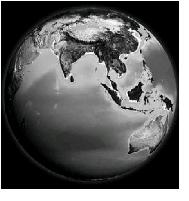At Copenhagen, Third World countries are demanding hundreds of billions of dollars in reparations from the West for the consequences of the West’s fossil fuel burning, among them droughts and crop failures.

A NASA satellite image illustrating the increase in plant life as a result of rising levels of carbon dioxide.
Third World countries have it backwards. The West’s CO2 emissions have been increasing crop yields while helping to ease the Third World’s water shortages. Rather than plead for reparations, Third World governments should offer a paean to Providence.
The bureaucrats at Copenhagen dread high CO2 levels. The biosphere craves them. Plants evolved when CO2 levels in the atmosphere stood at a healthy 1000 parts per million, two-tothree times today’s paltry level of about 380 parts per million. Plants crave CO2 so much that commercial greenhouse operators often enrich greenhouse air with CO2 — also known as nature’s fertilizer — to levels of 1500 parts per million, or four times that of our current atmosphere.
Since humans began adding CO2 to the planet’s atmosphere, taking plants off their starvation rations by creating a planet-wide greenhouse, plants have thrived. Data from NASA satellites, which since the early 1980s have been tracking the amount of biota on Earth, vividly demonstrate the results. As CO2 emissions grew in leaps and bounds, so did plants — the data shows planet Earth is now greener than when those satellite measurements began.
Growth in greenery varies from country to country, and within countries, because climatic factors are so many and so varied, but the overall trend is clear, and especially in the Third World. The Indian subcontinent, the Amazon, the tropical countries generally, all show marked improvement, with studies pointing to improvements in carbon dioxide levels as an important factor.
China, which includes some of the most resource-stretched regions on the planet, provides the most dramatic demonstration of the boon in biota. As shown in a 2007 analysis by academics at the country’s prestigious Beijing Normal University, China’s plant growth increased by an astounding 24 % over the 18-year period studied, 1982 to 1999. The Chinese analysis, which like many others was based on satellite data, notes that China’s resourceconstrained regions sometimes did particularly well. In water-constrained Northwest China, for example, plant growth increased by 29%. In Northeast China and the Tibetan Plateau, where temperatures ordinarily place severe limits on vegetation, plant growth increased by 30%. South China and East China, where sunlight is a limiting factor, saw plant growth increase by a still-impressive 19%. Changes in CO2 during those 18 years correlated well with the changes in vegetation.
That plants love CO2 comes as no surprise — CO2 is not only their food, it is a gas to which they are superbly adapted. When the air is rich in CO2, plants don’t need to work as hard to breathe it in, letting them reduce the number of stomata, or air pores, on the surfaces of their leaves. Fewer pores means the plants breathe out less water vapour, letting them conserve moisture and better survive droughts. CO2 also helps plants survive droughts and other adverse conditions by extending their root systems, allowing them to collect minerals and moisture from afar. Through other mechanisms, CO2 protects plants against insect infestations, soil salinity and other environmental threats.
This gas — also known as the gas of life — is healthful and helpful to humans, too. CO2 not only boosts agricultural yields, it boosts the antioxidant and vitamin content in plants, as well as their essential minerals. Also importantly, CO2 helps make hospitable marginal areas of the world that would otherwise be inhospitable.
Industrialization in the West, along with the fossil fuel burning that it has entailed, has been a win for the West and a win for the world, including the Third World. The colourless, odourless, tasteless gas called CO2 is indispensable to life and, because China and India are certain to rapidly increase their CO2 emissions, the world will soon be getting more of it. They say you can have too much of a good thing. With CO2, the science tells us, the planet is far, far away from reaching its cornucopia potential.
Lawrence Solomon is executive director of Energy Probe (energy.probeinternational.org) and Urban Renaissance Institute and author of The Deniers: The world-renowned scientists who stood up against global warming hysteria, political persecution, and fraud
Printed and distributed by NewpaperDirect | www.newspaperdirect.com, US/Can: 1.877.980.4040, Intern: 800.6364.6364 | Copyright and protected by applicable law.


